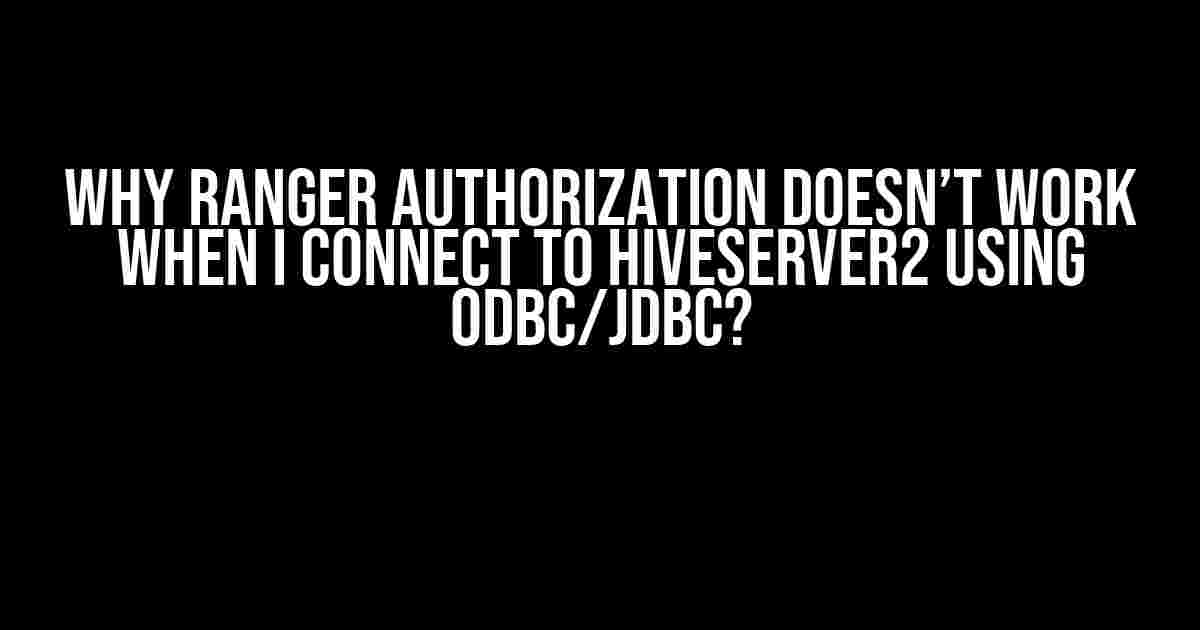Are you tired of getting frustrated when you try to connect to HiveServer2 using ODBC/JDBC, only to find that Ranger authorization doesn’t work as expected? You’re not alone! In this article, we’ll delve into the common pitfalls and provide clear, step-by-step instructions to get you up and running with Ranger authorization when connecting to HiveServer2 using ODBC/JDBC.
Understanding the Basics
Before we dive into the solutions, let’s quickly review the basics:
- HiveServer2: HiveServer2 is a server interface that enables remote clients to execute queries against Hive. It’s the default service used by Hive clients, including ODBC and JDBC.
- Ranger Authorization: Ranger is a security framework that provides fine-grained authorization for Hadoop components, including Hive. It allows you to define policies that control access to resources based on user roles and permissions.
- ODBC/JDBC: ODBC (Open Database Connectivity) and JDBC (Java Database Connectivity) are APIs that enable applications to connect to databases. In the context of Hive, ODBC and JDBC are used to connect to HiveServer2.
Common Issues
So, why doesn’t Ranger authorization work when you connect to HiveServer2 using ODBC/JDBC? Here are some common issues to watch out for:
- Incorrect Configuration: Misconfigured Ranger policies or HiveServer2 settings can prevent Ranger authorization from working correctly.
- Incorrect Driver Version: Using an outdated or incorrect ODBC/JDBC driver can cause compatibility issues with Ranger authorization.
- Authentication Issues: Authentication problems, such as incorrect usernames or passwords, can prevent Ranger authorization from working.
- TLS/SSL Encryption: Failing to configure TLS/SSL encryption correctly can cause issues with Ranger authorization.
Solving the Issues
Now that we’ve identified the common issues, let’s walk through the solutions:
Step 1: Verify Ranger Configuration
Ensure that Ranger policies are correctly configured for Hive. Check the following:
- Verify that the Hive service is enabled in Ranger.
- Check that the correct Hive repository is configured in Ranger.
- Ensure that the Ranger policy is correctly applied to the Hive service.
// Example Ranger policy configuration
{
"policyType": "HIVE",
"repoType": "HIVE",
"repo": "hive_repo",
"serviceName": "HIVE",
"description": "Hive policy",
"policyItems": [
{
"users": ["user1", "user2"],
"groups": ["group1", "group2"],
"repositories": ["hive_repo"],
"permissions": ["SELECT", "INSERT", "UPDATE", "DELETE"]
}
]
}
Step 2: Verify ODBC/JDBC Driver Version
Ensure that you’re using a compatible ODBC/JDBC driver version. Check the driver version against the HiveServer2 version:
| HiveServer2 Version | ODBC/JDBC Driver Version |
|---|---|
| HiveServer2 2.x | ODBC: 2.6.1, JDBC: 2.6.4 |
| HiveServer2 3.x | ODBC: 3.0.0, JDBC: 3.0.0 |
Step 3: Verify Authentication
Ensure that authentication is correctly configured. Check the following:
- Verify that the username and password are correct.
- Check that the authentication mechanism is correctly configured (e.g., Kerberos, LDAP, or custom authentication).
// Example ODBC connection string with authentication
DRIVER={Hive ODBC Driver};
HOST=localhost;
PORT=9083;
UID=user1;
PWD=password;
AuthMech=3;
KrbServiceName=hive;
KrbHostFQDN=localhost
Step 4: Verify TLS/SSL Encryption
Ensure that TLS/SSL encryption is correctly configured. Check the following:
- Verify that the correct TLS/SSL protocol is configured (e.g., TLSv1.2).
- Check that the certificate and private key are correctly configured.
// Example JDBC connection string with SSL encryption
jdbc:hive2://localhost:9083/;ssl=true;
trustStore=;
trustStorePassword=;
Conclusion
Getting Ranger authorization to work with HiveServer2 using ODBC/JDBC requires careful configuration and attention to detail. By following the steps outlined in this article, you should be able to resolve common issues and get Ranger authorization working as expected. Remember to verify Ranger configuration, ODBC/JDBC driver version, authentication, and TLS/SSL encryption to ensure a smooth and secure connection to HiveServer2.
Still having trouble? Check out our troubleshooting guide for more detailed instructions and common pitfalls to avoid. Happy querying!
Additional Resources:
- Hive Documentation: https://cwiki.apache.org/confluence/display/Hive/Home
- Ranger Documentation: https://cwiki.apache.org/confluence/display/RANGER/Home
- ODBC/JDBC Driver Documentation: https://docs.cloudera.com/HDPDocuments/HDP2/HDP-2.6.3/bk_hive-odbc-driver/content/odbc-driver-release-notes.html
Here are 5 Questions and Answers about “Why Ranger authorization doesn’t work when I connect to Hiveserver2 by using ODBC/JDBC?” :
Frequently Asked Question
Ranger authorization not working when connecting to Hiveserver2 via ODBC/JDBC? Don’t worry, we’ve got you covered!
Q1: Is Ranger authorization enabled in Hiveserver2?
A1: Make sure that Ranger authorization is enabled in Hiveserver2 by setting `hive.security.authorization.manager` to `org.apache.hadoop.hive.ql.security.RangerAuthorizationManager` in your `hive-site.xml` file.
Q2: Are the necessary Ranger jars included in the classpath?
A2: Ensure that the necessary Ranger jars are included in the classpath. Check if the `ranger-hive-plugin` jar is present in your classpath. If not, add it to the classpath and restart Hiveserver2.
Q3: Is the Ranger plugin configured correctly?
A3: Verify that the Ranger plugin is configured correctly by checking the `ranger-hive-plugin` properties in your `hive-site.xml` file. Ensure that the `ranger.plugin.hive` property is set to `true` and the `ranger.service.name` property is set to the correct Ranger service name.
Q4: Are the ODBC/JDBC connections using the correct authentication?
A4: Ensure that the ODBC/JDBC connections are using the correct authentication mechanism. Make sure that the connections are using the `RangerAuthentication` mechanism and not the default `NoSaslAuthentication`.
Q5: Are there any Ranger audit logs indicating the issue?
A5: Check the Ranger audit logs to see if there are any error messages indicating the issue. This can help you identify the root cause of the problem and take corrective action.
I hope this helps! Let me know if you need any further assistance.
